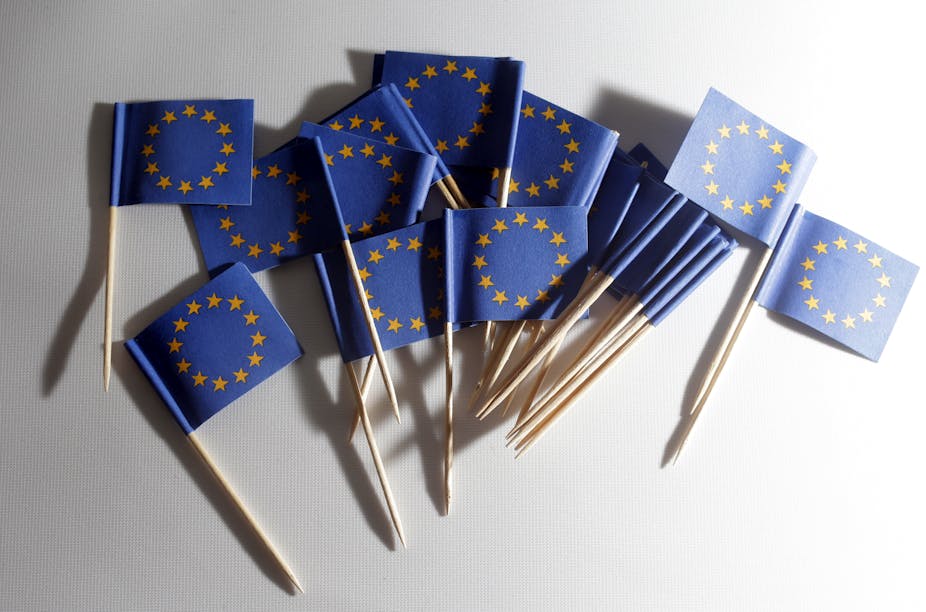Few competitions pitch the whole of Europe against the United States. The Ryder Cup began formally in 1927 as a contest between Great Britain and the US. It was expanded to include first Ireland and then continental Europe in 1979 –- this was partly to include a new generation of top-class Spanish golfers. Since then the Europeans have won nine out of 17 contests (it takes place every two years), so the chances of victory are certainly boosted by drawing upon a wider group of talent.
But how many fans on the eastern side of the Atlantic will wave the European flag during this competition? And if so how deeply do those feelings of European-ness really run?

Euro-symbolism
The EU has made numerous efforts to promote a sense of European identity since the 1970s through the European anthem, the European flag, European cities of culture, Europe Day on May 9 (have you ever heard of it?). Yet support for European identity as such is low. The Eurobarometer, which began monitoring it in 1973, has recorded a continually low score. Around 2% of Europeans feel that they are European only and this has fallen in recent years with the upsurge of anti-EU parties and sentiment.
The question in the Eurobarometer is phrased: “In the near future, will you think of yourself as a … European only, European and own nationality, own nationality and European, own nationality only”. In the most recent survey, “own nationality only” was just 39% and “own nationality and European” was 51%. Both are rising slightly, but this relatively low emphasis on nationality has led scholars to talk about “nested identity” with people feeling European in addition to their local or national affiliations. The UK leads the way in national-only sentiments at 64%, while 21% of Luxembourgians (the most pro-European country) see themselves as European only.
The demographics of euro-identity
To answer the question of if and how European identity will be celebrated at the Ryder Cup, we need to drill down into the demographics. Men are more likely to think of themselves as European than women, as are those with higher levels of education and higher income. This of course corresponds with those in higher social classes having greater European identification too.
Young people are more likely to think of themselves as European as well, having grown up in a world where a borderless and united Europe was taken for granted. As you’d expect, those with a more left-wing orientation are more likely to see themselves as European and those with more right-wing orientation as nationalistic, supporting restrictions on movement of people around Europe, for example. The higher-class supporters of golf are therefore more likely to see themselves as European, but since they are also likely to be older people, that might undermine the trend.
Feeling European is highly correlated with how much a person has travelled and their ability to speak other European languages. Here the effect of various mobility programmes such as Erasmus might have had an effect as large numbers of young people move around for their education. It might also reinforce the British exception, however, since young people from here are less likely to go on these schemes or to learn foreign languages.
While people usually have a firm sense of the boundaries of their own country, most people in Britain don’t know which countries are in the EU or where its borders lie. They nevertheless feel qualified to voice strong opinions about it. Few respondents in studies can even say what rights they have as a result of being European citizens, so the sense of citizenship is very weak. The continual enlargements and various accession agreements probably help to muddle the picture. Yet this could be important for the Ryder Cup – what budding golfers might there be in Serbia or in Croatia who might play in the competition in years to come?
The European history syllabus
Most people also have a strong sense of the history of their country; they learn it in school. But the history of Europe is more diffuse and complicated and not studied to the same extent. The arcane administrative complexities of the EU are generally only studied by those taking it as a specialist subject at a higher level. In European countries such as Germany, however, citizenship lessons are more likely to include information about Europe and the EU, which might explain why their young people are more pro-European as well.

Might there be an argument for including this information in citizenship education for young people in Britain? If people are to vote in a referendum on the EU, don’t they deserve to be better informed? After all, European symbols are rather low key, boring and administrative –- a standardised passport and car number plates do not inspire passion. They do not provide a warm fuzzy sense of emotional belonging in most people, nor inspire them to wave flags or reach for the face paint.
It is clear that for those outside the EU, it represents an ideal of regulated prosperity, peace and security as setting high standards in environmental cleanliness and quality of life. Ukraine has just suffered a civil war over the signing of an association agreement with the EU. Many people in countries from north Africa, the Caucasus and the Middle East would love to enjoy the regulated and mundane harmony that Europeans take for granted. But these are slowly evolving and hard won achievements. There are always a few European flags flying at the Ryder Cup, but the feeling of shared identity remains shallow.

